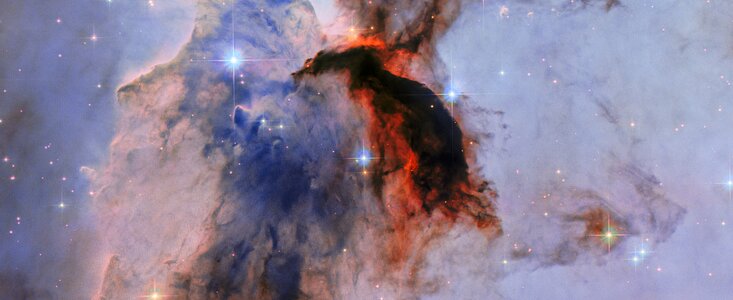heic2507 — Photo Release
Hubble spies a cosmic pillar in the Eagle Nebula
18 April 2025
In anticipation of the upcoming 35th anniversary of the NASA/ESA Hubble Space Telescope, ESA/Hubble is continuing the celebrations with a new view of the Eagle Nebula. This vast stellar nursery displays a towering spire of cosmic gas and dust that incorporates new data processing techniques developed since an image of this region was last released two decades ago.
Does this Hubble image of a sculpted pillar of gas and dust look to you like a curling party streamer, a plume of smoke from a blown-out candle, or an unusual balloon? Regardless of what you see when you gaze at this cosmic cloud, this new portrait is a cause for celebration.
As part of ESA/Hubble’s 35th anniversary celebrations, a new image series is being shared to revisit stunning Hubble targets that were previously released. New images of NGC 346 and the Sombrero Galaxy have already been published. Now, ESA/Hubble is revisiting the Eagle Nebula (originally published in 2005 as part of Hubble's 15th anniversary celebrations) with new image processing techniques.
Unfurling along the length of the image is a pillar of cold gas and dust that is 9.5 light-years tall. As enormous as this dusty pillar is, it’s just one small piece of the greater Eagle Nebula, which is also called Messier 16. The name Messier 16 comes from the French astronomer Charles Messier, a comet hunter who compiled a catalogue of deep-sky objects that could be mistaken for comets.
The name Eagle Nebula was inspired by the nebula’s appearance. The edge of this shining nebula is shaped by dark clouds like this one, giving it the appearance of an eagle spreading its wings.
Not too far from the region pictured here are the famous Pillars of Creation, which Hubble has photographed multiple times, with images released in 1995 and 2015.
The heart of the nebula, which is located beyond the edge of this image, is home to a cluster of young stars. These stars have excavated an immense cavity in the centre of the nebula, shaping otherworldly pillars and globules of dusty gas. This particular feature extends like a pointing finger toward the centre of the nebula and the rich young star cluster embedded there.
The Eagle Nebula is one of many nebulae in the Milky Way that are known for their sculpted, dusty clouds. Nebulae take on these fantastic shapes when exposed to powerful radiation and winds from infant stars. Regions with denser gas are more able to withstand the onslaught of radiation and stellar winds from young stars, and these dense areas remain as dusty sculptures like the starry pillar shown here.
This image was developed using data from the Hubble observing programme #10393 (PI: K. Noll).
More information
The Hubble Space Telescope is a project of international cooperation between ESA and NASA.
Image Credit: ESA/Hubble & NASA, K. Noll
Links
Contacts
Bethany Downer
ESA/Hubble Chief Science Communications Officer
Email: [email protected]
About the Release
| Release No.: | heic2507 |
|---|


